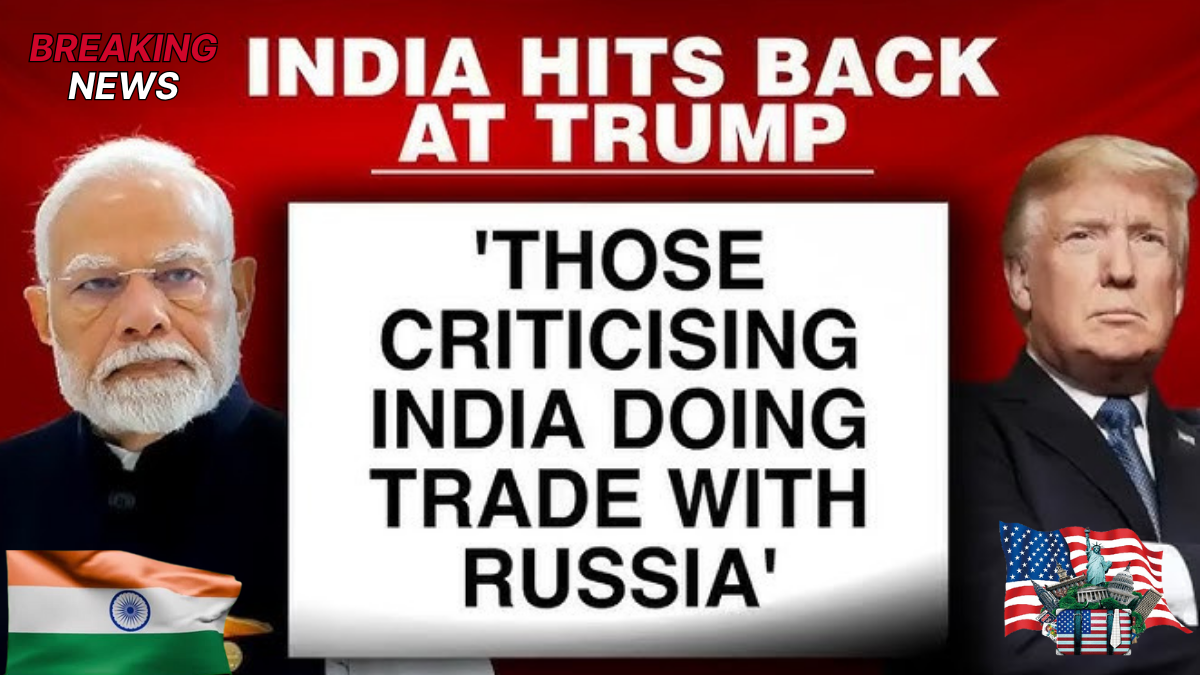Former US President Donald Trump has once again stirred global headlines with his pointed remarks aimed at India, threatening tariff hikes due to its ongoing oil trade with Russia. While such a stance may be politically advantageous in the US domestic arena, it contradicts earlier American strategies and reveals the complex web of geopolitics surrounding energy security. This article explores Trump’s statement, India’s energy policies, historical context, and the diplomatic tension it could fuel.

Summary Table: Donald Trump’s Tariff Warning to India
| Key Point | Details |
|---|---|
| Topic | Trump’s tariff threat to India over Russian oil imports |
| India’s Oil Trade with Russia | Russia supplies around 30–35% of India’s crude oil |
| US Position in Trump’s Previous Term | US once encouraged Russian oil purchases to stabilize markets |
| India’s Stance | Not violating any international law; prioritizes national interest |
| Oil Sources | 41 countries; key ones include Russia, Iraq, Saudi Arabia, UAE, USA |
| Impact of Tariff Threat | India asserts strategic autonomy; refuses to yield to pressure |
| Official Government Response | External Affairs Minister S. Jaishankar pushed back at Western criticism |
| Official Government Site | https://mea.gov.in |
Trump’s Tariff Threat: The Core of the Controversy
In recent interviews and campaign statements, Donald Trump has issued stern warnings to countries continuing trade ties with Russia — especially in oil. India, which imports nearly a third of its crude oil from Russia, finds itself in the crosshairs. Trump’s threat includes the possibility of raising tariffs on Indian exports to the US if the oil trade persists.
However, many observers have pointed out the contradiction in Trump’s posture. During his previous term as President, Trump and several top advisers had actively encouraged the global purchase of Russian oil to avoid market instability. This strategy aimed to prevent dramatic price spikes and inflation in global fuel markets.
Historical Background: US Encouragement of Russian Oil Trade
In the earlier Trump administration, US officials took a pragmatic view of Russian oil. While sanctions were imposed on Iran and Venezuela, Russia was allowed to continue energy exports under monitored conditions. The rationale was simple: banning Russian oil outright could trigger global oil shortages and hurt Western economies — including the US.
This leniency gave countries like India an opportunity to negotiate favorable oil deals with Russia. Russia offered steep discounts on crude prices — sometimes selling at or below the G7’s $60 per barrel cap — making it an attractive option for cost-sensitive economies like India.
India’s Justification: Legal, Strategic, and Economic
India has consistently defended its oil trade with Russia on legal and strategic grounds:
- Legality: Russian oil is not under any globally mandated sanctions. India has stated that should such sanctions be imposed multilaterally — with consensus from institutions like the UN — it would comply. Until then, there is no legal violation in trading with Russia.
- Strategic Autonomy: India’s foreign policy emphasizes self-reliance and independence in decision-making. Energy security is a non-negotiable national interest.
- Economic Necessity: With a population of over 1.4 billion and significant oil demand, India needs affordable and consistent energy sources. Russian oil, sold at a discount, is crucial for keeping inflation under control and supporting economic growth.
India’s Crude Oil Imports: A Global Basket
India’s oil strategy is diversified, importing from approximately 41 countries to ensure energy security. As of mid-2025:
- Russia: 30–35% of total imports
- Iraq: Around 15%
- Saudi Arabia, UAE, US, Kuwait: Each contributes between 5–8%
- Others: Smaller shares from Nigeria, Mexico, Brazil, and more
This broad sourcing base allows India to reduce dependence on any single country and navigate supply chain shocks more effectively. The move toward Russian oil was not ideological but practical — it was affordable, easily available, and compatible with domestic refinery capabilities.
Global Oil Dynamics and Western Double Standards
In early 2024, External Affairs Minister S. Jaishankar took a firm stand at the Munich Security Conference. He highlighted a critical hypocrisy — while Western nations publicly condemned India’s trade with Russia, many of them were quietly doing the same. In some instances, Russian crude was rerouted through third countries and purchased by Western buyers, often at a premium.
This criticism has exposed the double standards in the West’s sanctions regime. Nations like Germany, Italy, and others have continued Russian energy imports in one form or another, particularly natural gas, further validating India’s position.
Trump’s Statement: Domestic Politics or Foreign Policy?
Donald Trump’s threat may be less about actual trade policy and more about political theater. His approach fits into a larger narrative used during election seasons — portraying America as being taken advantage of by foreign nations. India, with its growing tech and pharmaceutical exports, becomes an easy target for this rhetoric.
However, experts caution that such threats, if turned into policy, could strain US-India relations. Over the past two decades, India and the US have significantly deepened their strategic, economic, and defense partnerships. Tariff escalation would contradict this growing alliance and may push India to further diversify away from US economic dependence.
India’s Official Response: Calm and Unyielding
India has not reacted emotionally to Trump’s statements. Government sources have reiterated that:
- Energy purchases are guided by national interest
- There is no breach of international law
- India will resist coercion from any nation
India has also emphasized its efforts toward transitioning to clean energy. Massive investments are being made in solar, wind, and green hydrogen, with plans to reduce fossil fuel dependency over time. But until that transition matures, the country cannot afford to compromise on its current energy needs.
FAQs: India-Russia Oil Trade and U.S. Tariff Threats
1. Why is Donald Trump threatening tariffs on India?
Trump has criticized India for continuing oil trade with Russia and has warned of possible tariffs. However, this contrasts with his earlier policy that encouraged Russian oil purchases to stabilize global markets.
2. Is India violating any international sanctions by buying Russian oil?
No. Russian oil is not under a universal embargo. India has stated that it abides by international law and will comply with sanctions only if they are multilaterally agreed upon.
3. How much oil does India import from Russia?
As of 2025, around 30–35% of India’s crude oil imports come from Russia, making it the top supplier.
4. Why is Russian oil attractive to India?
Russian oil has been offered at deep discounts, often under the $60 per barrel G7 price cap, making it cost-effective for India’s energy needs.
5. Could this impact US-India relations?
If tariffs are implemented, it could strain ties. However, India is likely to maintain its independent foreign policy stance and resist coercive economic measures.
Conclusion: India Will Prioritize Strategic Autonomy
In summary, the U.S. tariff threats under Donald Trump, though politically charged, are unlikely to sway India’s energy policies. India remains focused on its long-term energy security and economic priorities. The nation’s refusal to be dictated to by external powers reaffirms its stance as an independent geopolitical actor.
The Trump administration’s past contradictions, global oil dynamics, and widespread Western dependence on Russian energy only strengthen India’s defense. Unless comprehensive, legally binding sanctions are introduced, India will continue sourcing oil based on cost-effectiveness and strategic need — not pressure or politics.
Official Links
- Ministry of External Affairs, India – Official Website
- Petroleum Planning & Analysis Cell
- U.S. Department of State – India Relations
For More Information Click HERE





